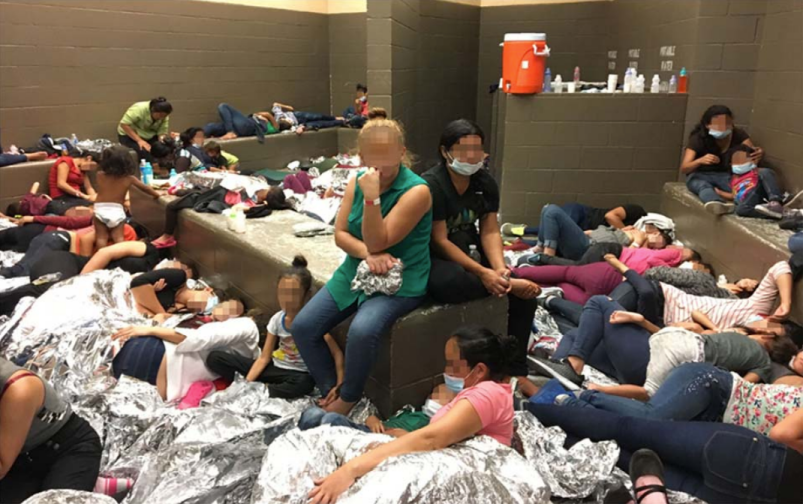The dangerous overcrowding and prolonged detention of children and adults at several government-run detention facilities at the border requires “immediate attention and action,” investigators inside the Department of Homeland Security said in a report Tuesday.
In the latest government report to shed light on detention facilities at the border, DHS Office of Inspector General investigators included pictures of severely overcrowded facilities in the Rio Grande sector of the border.
The so-called “management alert” follows another such alert in May, which addressed adult facilities in El Paso Del Norte Processing Center.
Per the report, detained migrants and asylum seekers were held for prolonged periods at all five of the Customs and Border Protection facilities the investigators visited.
“Border Patrol was holding about 8,000 detainees in custody at the time of our visit,” the report read, “with 3,400 held longer than the 72 hours generally permitted under the TEDS [Transport, Escort, Detention and Search] standards.”
“Of those 3,400 detainees, Border Patrol held 1,500 for more than 10 days.”






The facilities are known for their freezing temperatures, concrete floors, frequently poor sanitary conditions and caged enclosures. A federal judge on Friday ordered the government into mediation over allegations from attorneys representing children in detention that the Trump administration wasn’t meeting its responsibilities to make facilities in El Paso and Rio Grande sectors “safe and sanitary.”
The conditions in one such facility flagged by lawyers in a series of media interviews, in Clint, Texas, made national headlines and spurred public outcry. Several members of Congress recently toured CBP facilities on the border. Another government standard established by the so-called Flores Agreement, that children shall not be held in custody longer than 20 days, “is not being met,” Rep. Katherine Clark (D-MA) said outside an El Paso facility Tuesday.
The problems are partly systematic, the report granted, noting that the two agencies that would take custody of adults and children following CBP detention, Immigration and Customs Enforcement and the Department of Health and Human Services, respectively, “are operating at or above capacity.”
The investigators confirmed lawyers’ claims that access to showers was scarce, if non-existent in some facilities.
“[C]hildren at three of the five Border Patrol facilities we visited had no access to showers, despite the TEDS standards requiring that ‘reasonable efforts’ be made to provide showers to children approaching 48 hours in detention,” they wrote, adding later that “two facilities had not provided children access to hot meals — as is required by the TEDS standards — until the week we arrived.”
They observed separately: “Most single adult detainees were wearing the clothes they arrived in days, weeks, and even up to a month prior. Further, although TEDS standards require agents to remain cognizant of detainees’ religious and other dietary restrictions,13 many single adults had been receiving only bologna sandwiches. Some detainees on this diet were becoming constipated and required medical attention.”
The investigators expressed concern that the conditions threatened the health and safety of detained people and DHS agents.
“At the time of our visits, Border Patrol management told us there had already been security incidents among adult males at multiple facilities,” they wrote. “These included detainees clogging toilets with Mylar blankets and socks in order to be released from their cells during maintenance. At one facility, detainees who had been moved from their cell during cleaning refused to return to their cell. Border Patrol brought in its special operations team to demonstrate it was prepared to use force if necessary.”
One site visit was ended early, the investigators wrote, after detainees saw them: “[T]hey banged on the cell windows, shouted, pressed notes to the window with their time in custody, and gestured to evidence of their time in custody (e.g., beards).”
Responding to the report, DHS’ liaison Jim H. Crimpacker wrote that the “current situation on the Southern Border represents an acute and worsening crisis” given the large numbers of people crossing the border monthly. He said CBP had added tents to handle some new arrivals but urged congressional action “to address legal and judicial loopholes” that he said incentivize migration.
The OIG, responding in turn, wrote that “we remain concerned that DHS is not taking sufficient measures to address prolonged detention in CBP custody among single adults.”







Ok, Now we’re getting a clearer picture of why Pence was recalled today… First the CBP official surveillance company gets suspended (an almost unheard-of thing for a big government contractor), now the first photos of Abu Ghraib West are coming out…
ETA: Very interesting timing in this one. They got clearance from GAO just yesterday, and released this today. Someone worried about it getting covered up if they didn’t move quick enough?
ETA2: Oh, now a certain resignation last week just got some extra perspective:
If those pictures were black&white they could almost be interchangeable with pictures from the late 30/40’s.
I want to add that this is costing us the taxpayer over $700 per person per day… what the fuck, it would be cheaper to put them up in Motel 6’s with meals catered from Denny’s.
And the Republicans and Evangelicals remain silent.
Other than to blame Obama.
Except the numbers are just now approaching those from years ago. It is not that DHS is overwhelmed but that they have consciously decided to make things as bad as possible. Must build wall…is the only response, a fucking wall will do nada.
As instructed by hair fuhrer: